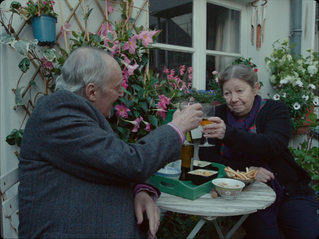Paris, Texas
- Kirby Moore
- Jan 2, 2021
- 2 min read
Updated: Feb 2, 2021
Wim Wenders, 1984

1984 saw the release of Wim Wenders’ Paris, Texas, a film whose saturated colours sustain the narrative’s sense of familial reconstruction, while capturing the quintessential nostalgia of 80’s cinema.
Considered a road movie in genre, Paris, Texas is set against a myriad of backdrops: the vast Mojave Desert, a highway, a middle-of-nowhere motel, a gas station, diner, airport, a parking lot, the unsettling atmosphere of American suburbia, another parking lot, hotels, winding overpasses, and one final parking lot. Throughout the film, the principal character, Travis (Harry Dean Stanton), never stops travelling. The narrative carries with it an existential air – one of vague recollection laced with a kind of uncertainty that is perpetuated by constant movement. The spaces he inhabits are never destinations, but places of transit, places encountered only because of a necessity to move through them, liminal places that carry a fascinating sense of trapped time. The film’s only glimpse of a place of terminus for Travis, is an old photograph of some land he bought in Paris, Texas. These feelings of liminality and restorative purpose are maintained by one of the film’s most prominent aesthetic features: colour.
Cinematically, Paris, Texas is beautiful. Lighting, costume and set, by Robby Müller, Birgitta Bjerke and Anne Kuljian respectively, employ the use of, most discernibly, red and green. Their coexistence supports and accompanies the poignant journey captured in the film.
A consistent accent present throughout the film, the colour red links the various places Travis passes through: a diner booth, a pair of shoes, a cigarette box, a radio. It is also adopted into the characters’ wardrobes, acting as a visual cue that indicates Travis’ intent to rebuild his fractured family. In the opening scenes, Travis wears a red baseball cap. This is later mirrored by his son, Hunter (Hunter Carson), and his wife, Jane (Nastassja Kinski), who are both seen in variations of red. Travis and Hunter wear bright red shirts on their journey to find Jane, whose introduction sees her in a room with red décor and lighting, wearing a vibrant pink angora jumper-dress – a fresh and feminine take on this familial colour, but perhaps incompatible.

Green is also omnipresent. Green lighting appears frequently: the doctor’s clinic, the gas station, a phone booth, and finally the parking lot from which Travis observes the reunion of his wife and son. This sees both Jane and Hunter wearing deep green shirts, illuminated by the green hued city lights of Houston. Coupled with the green-lit parking lot where Travis stands, this scene provides a disjointed family reunion. For a moment, despite all three never being physically together throughout the duration of the film, they are finally – in a strange way – reunited.

Cutting from the final scenes, with red light filtering back into frame, the viridescent lights of the Houston cityscape recede into the horizon while the red flare of Travis’ headlights come into focus as he leaves his son, his wife, and Houston for, presumably, Paris, Texas.








Comments